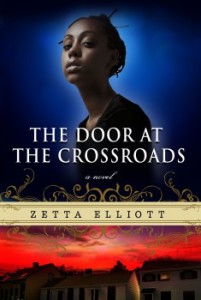Fans of Zetta Elliott’s 2008 time travel novel for teens, A Wish After Midnight (originally self-published, then republished by Amazon Encore in 2010) have waited a long time for the sequel. Patience, however, has been rewarded by a second volume as gripping and memorable as the first. The Door at the Crossroads, billed as boyfriend Judah’s story, is that and so much more – a tale of sacrifice for love, and a love that turns out to be more complex and problematic than the characters first believed. (Just like real life!)
 The novel from Elliott’s own imprint, Rosetta Press, begins on September 11, 2001, when 16-year-old Genna Colon witnesses the destruction of the Twin Towers from across the river in Brooklyn while her Jamaican-born boyfriend, Judah, remains in Brooklyn in 1863. Except that Judah is in even worse trouble. He has been kidnapped and sold into slavery down South, in a part of Georgia far from Union forces. Genna is torn between her life in the twenty-first century, where she is reconciling with her mother and looking forward to her older sister Toshi’s new baby, and her friends and Judah in Weeksville, a thriving nineteenth century African-American village within Brooklyn. While Genna battles with a white teacher who doesn’t appreciate her passionate insights on history, Judah endures harsh labor and beatings, and during an escape attempt he kills a white slave hunter. Eventually, he finds a Union encampment and makes his way to Weeksville, but he isn’t the same person who was separated from Genna at the portal months earlier. When Genna, with the help of Judah’s friend Peter, reopens the portal and returns to Brooklyn in 1863, all kinds of problems ensue, not the least of which is the fact that Peter, who is gay (and hasn’t told Judah) accidentally ends up going into the past with Genna.
The novel from Elliott’s own imprint, Rosetta Press, begins on September 11, 2001, when 16-year-old Genna Colon witnesses the destruction of the Twin Towers from across the river in Brooklyn while her Jamaican-born boyfriend, Judah, remains in Brooklyn in 1863. Except that Judah is in even worse trouble. He has been kidnapped and sold into slavery down South, in a part of Georgia far from Union forces. Genna is torn between her life in the twenty-first century, where she is reconciling with her mother and looking forward to her older sister Toshi’s new baby, and her friends and Judah in Weeksville, a thriving nineteenth century African-American village within Brooklyn. While Genna battles with a white teacher who doesn’t appreciate her passionate insights on history, Judah endures harsh labor and beatings, and during an escape attempt he kills a white slave hunter. Eventually, he finds a Union encampment and makes his way to Weeksville, but he isn’t the same person who was separated from Genna at the portal months earlier. When Genna, with the help of Judah’s friend Peter, reopens the portal and returns to Brooklyn in 1863, all kinds of problems ensue, not the least of which is the fact that Peter, who is gay (and hasn’t told Judah) accidentally ends up going into the past with Genna.
Elliott tells Genna and Judah’s story in alternating chapters. While Genna is in Brooklyn in 2001 and Judah is in the South, Judah has two chapters for every one of Genna’s. When Genna arrives in Brooklyn in 1863, she takes over most of the narrative. Ultimately, The Door at the Crossroads, like A Wish After Midnight, is Genna’s story, as it should be. Genna is a complex, multifaceted, and real character, one who can carry a multivolume series. Her romantic struggles are also complex and illuminating, as she comes to realize that the boy for whom she has sacrificed so much may not be worth the effort. Judah is both heroic and so deeply flawed as a person that she may not want to have anything to do with him again.
The Door at the Crossroads stands on its own – one doesn’t need to have read A Wish After Midnight to appreciate it. Both new characters such as Peter and ones that appeared in the earlier volume are fully developed, and the conflicts are fresh, with high and compelling stakes.
I don’t know if there’s a third volume in the works, but I hope there is and I won’t have to wait another six years to read it. In the meantime, The Door at the Crossroads is a novel to read, savor, and reread.
3 comments for “Returning to a Painful Past: A Review of The Door at the Crossroads”